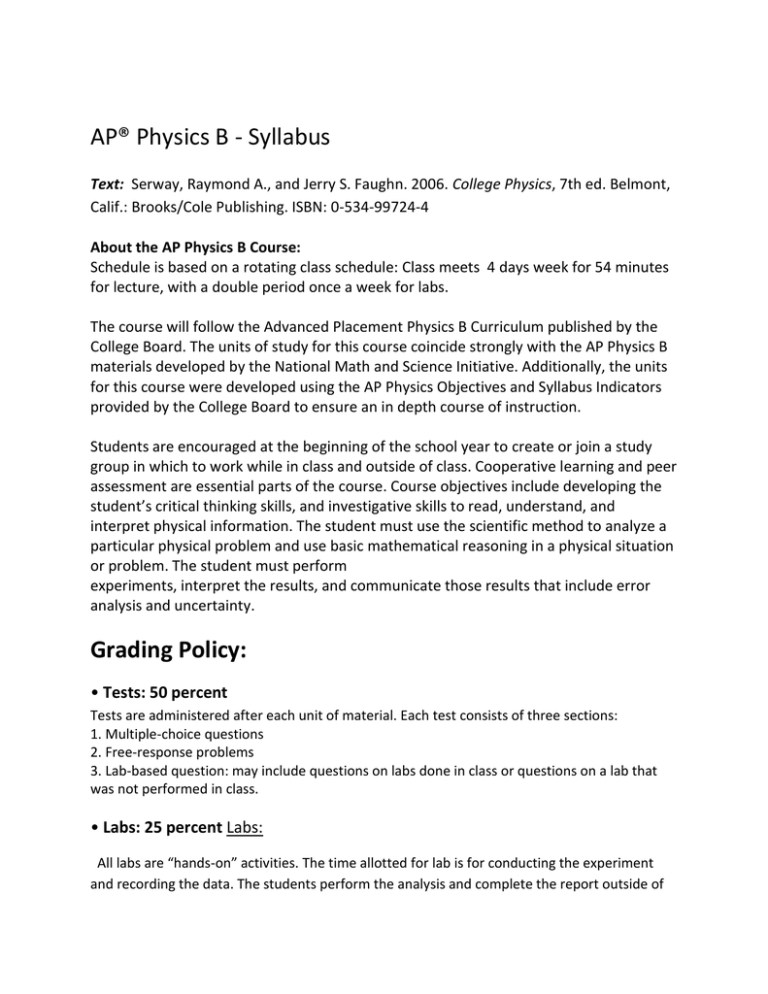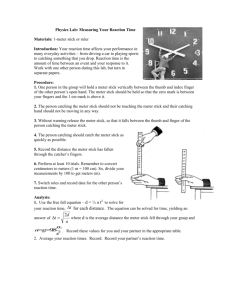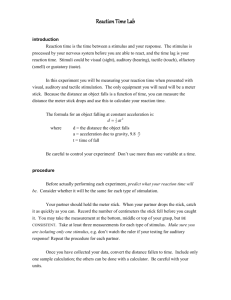ap physics syllbus updated for students 73113
advertisement

AP® Physics B - Syllabus Text: Serway, Raymond A., and Jerry S. Faughn. 2006. College Physics, 7th ed. Belmont, Calif.: Brooks/Cole Publishing. ISBN: 0-534-99724-4 About the AP Physics B Course: Schedule is based on a rotating class schedule: Class meets 4 days week for 54 minutes for lecture, with a double period once a week for labs. The course will follow the Advanced Placement Physics B Curriculum published by the College Board. The units of study for this course coincide strongly with the AP Physics B materials developed by the National Math and Science Initiative. Additionally, the units for this course were developed using the AP Physics Objectives and Syllabus Indicators provided by the College Board to ensure an in depth course of instruction. Students are encouraged at the beginning of the school year to create or join a study group in which to work while in class and outside of class. Cooperative learning and peer assessment are essential parts of the course. Course objectives include developing the student’s critical thinking skills, and investigative skills to read, understand, and interpret physical information. The student must use the scientific method to analyze a particular physical problem and use basic mathematical reasoning in a physical situation or problem. The student must perform experiments, interpret the results, and communicate those results that include error analysis and uncertainty. Grading Policy: • Tests: 50 percent Tests are administered after each unit of material. Each test consists of three sections: 1. Multiple-choice questions 2. Free-response problems 3. Lab-based question: may include questions on labs done in class or questions on a lab that was not performed in class. • Labs: 25 percent Labs: All labs are “hands-on” activities. The time allotted for lab is for conducting the experiment and recording the data. The students perform the analysis and complete the report outside of class. Students are required to keep a portfolio containing all their lab reports in case the college of their choice requires evidence, or documentation prior to awarding college credit for physics. (additional information in the lab section below) • Quizzes –20-25percent Quizzes: Quizzes may contain questions and/or problems from the homework, the reading assignments, and/or recently covered or previously learned material. • Homework and In-class Problems –1to 5 percent Homework assignments are given from the textbook and from AP Released Exams. Sometimes students will be graded on in-class problem-solving exercises, AP Released Exams. Most homework will not be graded but the student should expect in-class quiz over the homework. After each semester there is final exam that is 20% of your final grade. Each quarter grade is 40% of your total grade. Ipad,pc, tablet and Wireless Classroom rules o You may bring in your ipad, pc, or tablet to take notes or to refer to class documents. o You may bring in your ipad,pc, or tablet to turn in a lab report or take pictures for labs. o Refer to Student handbook for rules and guidelines. o The teacher at any point can ask for no use of electronic devices in the classroom. Course Outline INTRODUCTION Chapter 1: Math and Data Review (August 16) A. Algebra/Geometry review B. Data collection and analysis C. Vector addition 1. Graphical methods 2. Algebraic methods I. NEWTONIAN MECHANICS Chapter 2 & 3: Kinematics (August19-Sept 6) A. Motion in One Dimension 1. Position-time and velocity-time graphs 2. Equations of motion under constant acceleration B. Motion in Two Dimensions 1. Projectiles 2. Circular motion (Chapter 7) Chapter 4 &7: Newton’s Laws (Sept9– Sept 27) A. Static Equilibrium (First Law) 1. First Condition – translational equilibrium 2. Second Condition – rotational equilibrium (torque) B. Dynamics of a Single Body (Second Law) C. Systems of Two or More Bodies (Third Law) D. Gravitation E. Applications 1. Inclined planes 2. Atwood’s machines and their modifications 3. Static and kinetic friction 4. Horizontal and vertical circles 5. Planetary motion Chapter 5& 6: Work, Energy, Power & Momentum (Sept 30 –Oct17) A. Work and Work-Kinetic Energy Theorem B. Conservative Forces and Potential Energy 1. Gravity 2. Springs C. Conservation of Mechanical Energy D. Power E. Simple Harmonic Motion (*Chapter 13) 1. Springs and Pendulums 2. Energies of SHM F. Momentum 1. Impulse-Momentum Theorem 2. Conservation of Linear Momentum and Collisions a. Inelastic, completely inelastic and perfectly elastic collisions b. Two-dimensional collisions II. FLUIDS MECHANICS & THERMAL PHYSICS Chapter 9: Fluid Mechanics (Oct 18-Nov 4) A. Density and pressure 1. Density and specific gravity 2. Pressure as a function of depth 3. Pascal’s Law B. Buoyancy – Archimedes’ Principle C. Fluid flow continuity D. Bernoulli's equation E. Applications 1. Hydraulics 2. Effects of atmosphere on weather, baseballs, etc. 3. Flotation and SCUBA 4. Flight 5. Plumbing Chapter 10 &11: Thermal Physics (Nov 5-Dec6) A. Temperature and Thermal Effects 1. Mechanical equivalent of heat 2. Heat transfer and thermal expansion a. linear expansion of solids b. volume expansion of solids and liquids 3. Calorimetry B. Kinetic Theory, Ideal Gases & Gas Laws C. Thermodynamics 1. Processes and PV diagrams 2. First Law of Thermodynamics a. Internal energy b. Energy conservation c. Molar heat capacity of a gas 3. Second Law of Thermodynamics a. Directions of processes b. Entropy 4. Heat Engines and Refrigerators Dec 9 -12 Review of EXAMS. Practice problems and Test Dec 16-20: Semester Exam III. WAVES Chapter 13 &14: Wave motion and Sound (Jan 13-22) A. Description and characteristics of waves B. Standing waves and harmonics 1. Waves on a string 2. Waves in a tube (open and closed) C. The Doppler Effect (in one dimension) D. Sound intensity, power and relative sound intensity E. Musical applications IV. ELECTRICITY & MAGNETISM Chapter 15 & 16: Electrostatics (Jan 23 –Feb 4) A. Coulomb’s Law B. Electric Fields and Gauss’ Law C. Electric Potential Energy and Electric Potential D. Capacitance 1. Graphical description of capacitance (charge vs. voltage) a. slope – capacitance b. area – energy stored 2. Capacitors in series and parallel E. Applications 1. Point charge distributions 2. Parallel plates 3. Cathode ray tubes 4. Millikan Oil Drop Experiment 5. Condensers, uninterruptible power supplies, tone controls Chapter 17&18: Current Electricity (Feb5 –Feb21 ) A. Electric Circuits 1. Emf, Current, Resistance and Power 2. DC circuits a. Series and parallel circuits b. Batteries and internal resistance c. Ohm’s Law and Kirchhoff’s rules d. Voltmeters and ammeters e. Capacitors in circuits (RC circuits) 3. Applications Chapter19 & 20 Electromagnetism (Feb 24 – March 11) A. Magnetostatics 1. Force of a magnetic field on a moving charge 2. Force of a magnetic field on a current carrying wire 3. Torque on a current carrying loop 4. Magnetic fields due to straight and coiled wires B. Electromagnetic Induction 1. Magnetic flux 2. Faraday’s Law and Lenz’s Law C. Applications 1. Mass spectrometers 2. Motors 3. Generators 4. Particle colliders V. OPTICS Chapter 22-24: Optics (March 12 –March 31) A. Geometric Optics 1. Reflection, Refraction and Snell’s Law a. Reflection and refraction at a plane surface b. Total internal reflection 2. Images formed by mirrors 3. Images formed by lenses 4. Ray Diagrams and the thin lens/mirror equation B. Physical Optics 1. The electromagnetic spectrum 2. Interference and path difference 3. Interference effects a. Single slit b. Double slit c. Diffraction grating d. Thin film VI. ATOMIC & NUCLEAR PHYSICS Chapter 27-30 Modern Physics (April April 17) A. Atomic Physics and Quantum Effects 1. Photons and the Photoelectric effect 2. X-ray production 3. Electron energy levels 4. Compton scattering 5. Wave nature of matter B. Nuclear Physics 1. Atomic mass, mass number, atomic number 2. Mass defect and nuclear binding energy 3. Nuclear processes a. modes of radioactive decay (α, β, γ) b. fission c. fusion 4. Mass-Energy Equivalence and Conservation of Mass and Energy April 22 –May 2: Review of the Fall and Spring Semester material May 5-14: AP Exam and Semester Exam Labs Labs are designed to foster critical thinking skills. All labs are hands on and in some labs, Vernier® Sensors with TI Calculator or LogPro3 software will be used to collect data and preform analysis. Students are given an objective, e.g. “Determine the coefficient of static friction of wood on wood”, and standard materials – string, ruler, protractor, mass set, light pulley, CBL, etc. In some cases, students are allowed to create their own experimental design, but ultimately the lab designs will lead to the collection of data which can be analyzed through graphical methods. Students must graph by hand using a ruler and graph paper, but are encouraged to check their work with a spread sheet or statistical functions on their graphing calculators. Students work in pairs, but each student must submit a lab report which is turned in the day after the conclusion of each activity, then graded and returned. Each Lab report will follow the below format • a statement of the problem • an hypothesis • a discussion or outline of how the procedure will be carried out, • the data recorded • a discussion or outline of how the data was analyzed • a conclusion including error analysis and topics for further study Below you will find the list of labs: 1. Motion at Incline in One Dimension Objective: To analyze the motion of objects moving at constant speed and at uniform accelerated motion. Data should be collected to produce a graph of x versus t and use the graph to plot a v- versus t-graph for each object. Equipment: Motion detector and Vernier® dynamic carts 2. Cart at an Incline Objective: To determine the acceleration due to gravity. Equipment: Motion detector and Vernier® dynamic cart 3. Vector Addition Objective: To compare the experimental value of a resultant of several vectors to the values obtained through graphical and analytical methods. Equipment: A force table set 4. Projectile Motion Objective: To determine the initial velocity of a projectile and the angle at which the maximum range can be attained Equipment: Ball Ramp, Photogates 5. Atwood Machine’s : Newton’s Second Law Objective: To determine the acceleration of a system and the tension in the string. Equipment: Modified Atwood’s machine, meter stick, stopwatch or photogate, and a set of masses 6. Static and Kinetic Friction Objective: Determination of static and kinetic coefficients of friction using two different methods. Equipment: Rectangular blocks of different materials (felt and wood), Dual Range Force Sensor, Motion Detector 7. Toy Popper Energy Objective: Determine the Kinetic, Potential and elastic energy of a toy “popper”. Equipment: “Popper” Toy, meter stick, electronic balance beam, tape 8. Linear Momentum Objective: Determine the velocity of each cart before and after collision. Equipment: dynamic cart track, two low-friction dynamics carts with Magnetic and Velcro™ bumpers, motion detectors 9. Centripetal Acceleration on a Turntable Objective: Measure the centripetal acceleration on the turntable. Determine the relationship between centripetal acceleration, radius, and angular velocity. Equipment: Low-g- accelerometer, turntable, masking tape, meter stick, mass, level 10.Potential Energy investigation: Spring and Gravitational Objective: To determine the spring constant of the spring, the evaluation of the extent to which the change in gravitational potential energy of the mass is equal to the change in the spring potential energy. Equipment: Hooke’s law apparatus, a set of masses, and a meter stick. 11.Potential Energy investigation: Spring and Gravitational Objective: To determine the spring constant of the spring, the evaluation of the extent to which the change in gravitational potential energy of the mass is equal to the change in the spring potential energy. Equipment: Hooke’s law apparatus, a set of masses, and a meter stick. 12.Period of Pendulum Objective: To determine the effects length and mass have on a pendulum Equipment: Stand, String, mass, protractor, stopwatch, measuring stick 13.Archimedes’ Principle Objective: To determine the density of two unknown materials. Equipment: Triple-beam balance, overflow can, beaker, various metal objects and string 14.Torricelli’s Theorem Objective: To determine the exit velocity of a liquid and to investigate the range attained with holes at varying heights Equipment: Clear plastic bottle with three holes at various heights, plastic container, water, and meter stick. 15.Coefficient of Linear Expansion Objective: The purpose of this lab is to measure the coefficient of thermal linear expansion for a selection of metals and compare the results to the theoretical values. Equipment: Linear expansion apparatus, Boiler and plastic tubing, Centigrade thermometer, Meter stick, two metal rods Paper towels and pot holders, Cup to catch run off. (This will be teacher guided experiment) 16.Ideal Gas Law Objective: To verify that the pressure of a gas (air) at a fixed temperature is inversely proportional to the gas volume, to verify that the volume of a gas at a fixed pressure is proportional to the gas temperature and to determine an experimental value for a constant that relates the temperature in Celsius to the absolute temperature. Equipment: Vernier® Gas Pressure Sensor, Vernier® Temperature Probe, plastic tubing with two connectors, rubber stopper assembly, flask, ring stand, utility clamp, hot plate, four 1 liter beakers, glove, ice 17.Sound Waves and Beats Objective: To determine the frequency, period, amplitude of sound waves and calculate the beats between the sounds of two tuning forks. Equipment: Vernier ® Microphone, 2 tuning forks 18.Speed of Sound Objective: To determine the speed of sound at standard pressure and temperature in air using a resonant air column. Equipment: Vernier ® Microphone, Vernier ® temperature probe, dog training clicker, resonance tube with plug, meter stick 19.Coulomb’s Law and Static Electricity Objective: To determine the charge on two spherical polystyrene balls. To make qualitative observations of the behavior of an electroscope when it is charged by conduction and by induction Equipment: Polystyrene balls, string, stand, and a meter stick. Electroscope and electrostatic materials set 20.Series and Parallel Circuits and RC Circuit Objective: Two Part Lab: Part 1: To investigate the behavior of resistors in series, parallel, and series-parallel circuits. The lab should include measurements of voltage and current. Part 2: Measure an experimental time constant of a resistor-capacitor circuit. Compare the time constant to the value predicted from the component values of the resistance and capacitance. Measure the potential across a capacitor as a function of time as it discharges and as it charges. Equipment: Circuit Board, 4 Resistors, non-polarized Capacitors, single-pole, double throw switch, Voltmeter, ammeter, Vernier ® Voltage and Current Probe, Batteries, connecting wires 21.Magnetic Field Investigation Objective: To map the magnetic field around a bar magnet and to determine the strength of the magnetic field Equipment: Bar magnet, compasses, meter stick and protractor 22.Electromagnetic Induction Objective: Build a solenoid and electromagnet. Then determine the following: Relationship between magnetic field and the current in a solenoid Relationship between magnetic field and the number of turns per meter in a solenoid. value of the permeability constant Equipment: Bar Magnet, nail, small and large wire, switch, meter stick, DC power supply, ammeter, cardboard spacers, connecting wires, tape and cardboard, Venier ® magnetic field sensor 23.Interference Objective: To determine the wavelength of a source of light by using a double slit and a diffraction grating of known spacing. Equipment: Diode Laser, slits, Meter stick 24.Index of Refraction Objective: Determine the index of refraction and critical angel of water and acrylic block Equipment: laser, meter stick, paper, protractor, small plastic tray, water, acrylic block. 25. Mirrors and Lenses Objective: Two Part Lab Part 1: Using a concave mirror, determine three locations where a real image can be formed and one where a virtual image is formed Part 2: Determine the focal length of a converging lens directly and the focal length of a diverging lens by combining it with a converging lens. Equipment: Optics bench, set of lenses and mirrors, light source 26. Photoelectric Effect Analogy Objective: To understand the concepts in the photoelectric effect and the equation. Student will be able to visualize some of the concepts in the photoelectric effect by using colliding balls to represent scattering particles and obstacles to represent energy thresholds. In order to illustrate the concept in a clearer way, the students will use a life-size model of a photon ejecting an electron to collect and analyze data. The lab and design of the model can be found at the following website: http://dev.physicslab.org/Document.aspx?doctype=2&filename=AtomicNuclear_Photoe lectricAnalogy.xml Equipment: An inclined track to roll a metal 1"-diameter metal ball down PVC tubes cut to approximately 7"-lengths with thin rubber bottoms One metal 1"-diameter ball Two collisions ball: plastic, aluminum, brass, or wood



